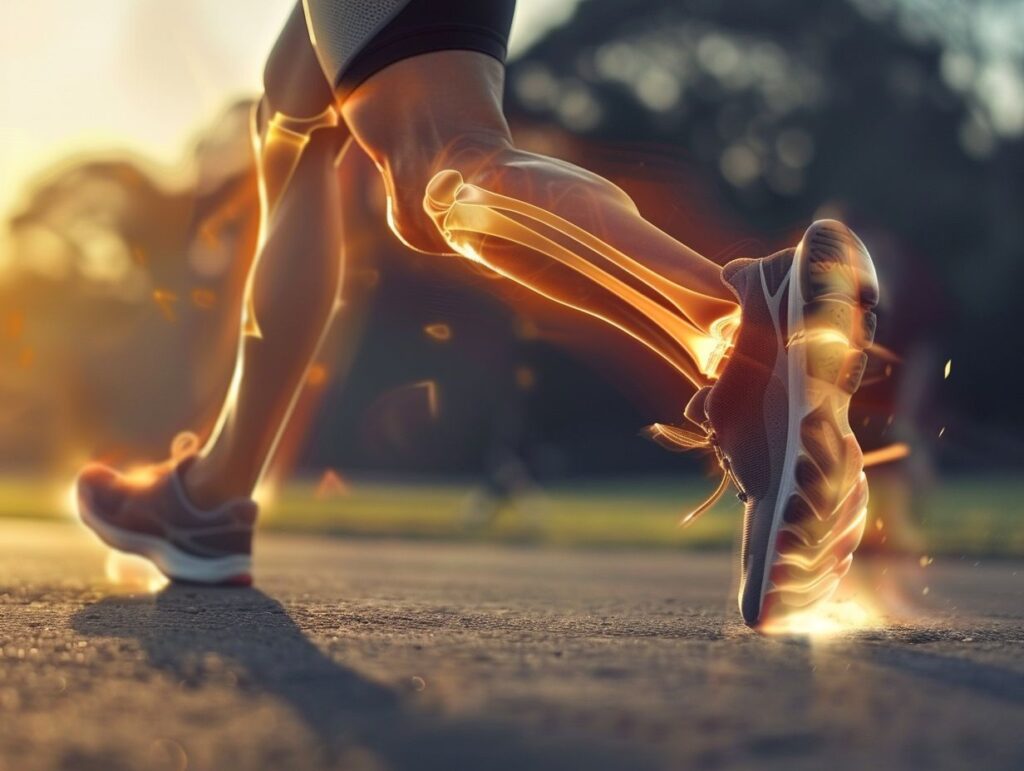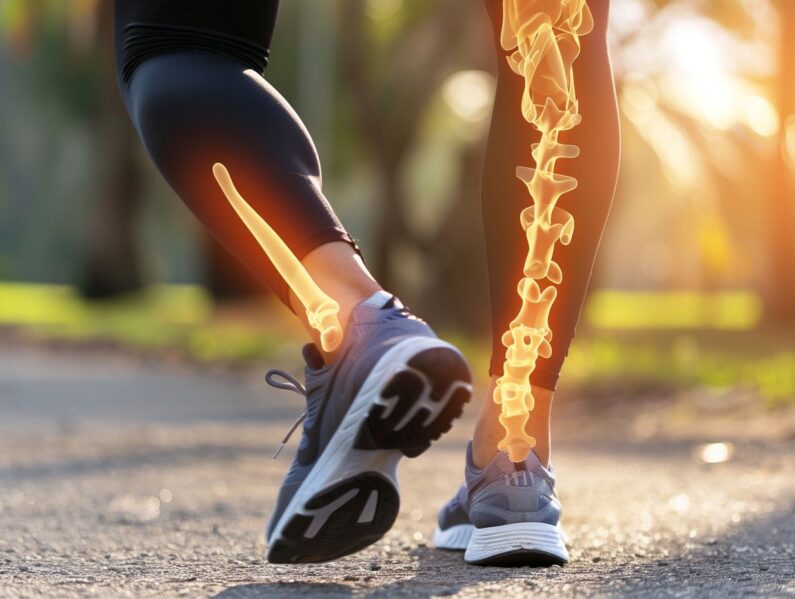Do you experience pain in the back of your leg while running? It could be due to various reasons such as muscle strain, tendinitis, sciatica, or even a stress fracture.
- We will explore the common causes, symptoms, prevention tips, treatment options, and when to seek medical attention for back of leg pain while running.
- Understanding this type of pain is crucial for your overall health and fitness goals, whether you are a seasoned runner or just starting out.
What Causes Back of Leg Pain While Running?
Back of leg pain while running can be caused by various factors such as muscle strain, calf issues, hamstring problems, shin splints, IT band syndrome, and Achilles tendonitis. These conditions can lead to discomfort and soreness during physical activity, especially for athletes.
Muscle strain in the back of the leg often results from overuse or sudden movements that stress the muscles, commonly affecting the calves and hamstrings. This can manifest as a dull ache or sharp pain, hindering running performance.
Calf issues, such as strains or tightness, can cause a deep, throbbing pain that worsens with activity, making it challenging to maintain a proper running form. If left untreated, these conditions can progress to more severe injuries, potentially leading to prolonged recovery periods and impacting overall athletic performance.
Muscle Strain
Muscle strain is a common cause of back of leg pain while running, characterized by discomfort and inflammation in the affected area. It often occurs due to overuse or improper warm-up techniques.
When muscles are strained during physical activities like running, microscopic tears in the muscle fibers result in pain and swelling. These tears can be minor, causing mild discomfort, or more severe, leading to significant impairment in movement. Runners experiencing muscle strain may notice tightness, tenderness, and bruising in the affected area.
Performance can be greatly impacted by muscle strain, causing a decrease in speed, endurance, and overall running efficiency. The discomfort and restricted range of motion can hinder training consistency and lead to frustration. It’s crucial to address muscle strain promptly to prevent further complications.
Tendinitis
Tendinitis in the back of the leg can lead to pain and discomfort while running, affecting the tendons in the calf, hamstring, or Achilles. It requires proper treatment and preventive measures to avoid worsening of the condition.
Symptoms of tendinitis may include stiffness, swelling, and tenderness in the affected area. Common causes of tendinitis include overuse, repetitive movements, improper form during exercise, or a sudden increase in physical activity. Ignoring these symptoms could lead to chronic pain and decreased mobility.
Physical therapy plays a crucial role in managing tendinitis by focusing on stretching and strengthening exercises to improve flexibility and reduce strain on the tendons. Engaging in targeted exercises can help alleviate symptoms and prevent future flare-ups of tendinitis.
Sciatica
Sciatica can manifest as back of leg pain while running, accompanied by symptoms like numbness and tingling. This condition originates in the lower back and can radiate down the leg, impacting an athlete’s performance.
Runners experiencing sciatica may find it challenging to maintain their regular training routine due to the discomfort and limitations it imposes. The pain associated with sciatic nerve irritation can be sharp and debilitating, hindering flexibility and mobility during physical activities. To manage these symptoms, incorporating specific stretches and exercises targeting the lower back and legs can help alleviate pressure on the sciatic nerve, promoting healing and reducing pain. By incorporating these strategies into their routine, runners can gradually improve their condition and resume their passion for running with reduced discomfort.
Stress Fracture
Stress fractures can result in back of leg pain during running, often caused by overuse or repetitive stress on the bones. Proper injury recovery and rest are crucial for healing such fractures and preventing further damage.
Symptoms of stress fractures may include localized pain, swelling, and tenderness in the affected area. Ignoring these symptoms can lead to more severe injuries, impacting your ability to run or engage in physical activities. Seeking professional help from a sports medicine specialist or physical therapist can aid in proper diagnosis and treatment.
Understanding the biomechanics of your running gait and foot strike can also help prevent future stress fractures by addressing potential issues in your form and technique. Gradually easing back into running activities after a period of rest is key to avoiding re-injury and promoting long-term bone health.
Nerve Compression
Nerve compression can lead to back of leg pain while running, resulting in numbness and discomfort along the affected nerve pathway. This condition may require professional help for accurate diagnosis and treatment.
When a nerve gets compressed, it can disrupt the normal flow of signals, causing sensations like shooting pain or tingling that can hinder an athlete’s performance. Ignoring these symptoms can lead to further complications and prolonged discomfort. Seeking assistance from a healthcare provider specializing in nerve-related issues is crucial to determine the root cause and develop an effective treatment plan. By addressing nerve compression proactively, athletes can prevent unnecessary pain and optimize their running performance.
What Are the Symptoms of Back of Leg Pain While Running?
Recognizing the symptoms of back of leg pain while running is crucial for early intervention. These may include sharp or burning pain, stiffness or tightness, and sensations like numbness or tingling.
Sharp or burning pain in the back of the leg may indicate issues such as muscle strains or tears, while stiffness or tightness could suggest muscle imbalances or overuse.
Numbness or tingling sensations are often associated with nerve compression or irritation, signaling potential conditions like sciatica or nerve entrapment.
Identifying these specific discomforts is essential as they provide valuable clues to the root cause of the pain, guiding proper treatment and preventing further inflammation or injury.
Sharp or Burning Pain

Sharp or burning pain in the back of the leg while running can indicate various underlying issues such as muscle strain, stress fractures, or sciatica. Understanding the nature of the pain is essential for effective treatment.
Runners experiencing sharp or burning pain should pay attention to the intensity, duration, and specific location of the discomfort to pinpoint the root cause. Muscle strain, which often feels like a sharp, stabbing pain, is commonly due to overuse or poor form. Stress fractures, characterized by a deep, throbbing ache, may result from repetitive impact or insufficient recovery. Sciatica, manifesting as a shooting or burning sensation down the leg, typically stems from compression of the sciatic nerve.
Proper diagnosis and targeted treatment are vital in managing such pain to prevent exacerbation and promote a safe return to running.
Stiffness or Tightness
Stiffness or tightness in the back of the leg while running can hinder an athlete’s performance and flexibility. Incorporating stretching routines and flexibility exercises is essential to alleviate such discomfort.
This tightness can restrict the range of motion in the muscles, leading to decreased power output and increased risk of injury. By engaging in dynamic stretches like leg swings and hip rotations before a run, you can enhance blood flow and loosen up the muscles.
Post-run static stretches such as hamstring stretches and calf stretches help improve muscle flexibility and reduce tightness. Making foam rolling a part of your routine can also aid in releasing tension in the muscles, promoting better overall muscle function and aiding in recovery.
Numbness or Tingling
Experiencing numbness or tingling in the back of the leg while running may indicate nerve compression or related issues. Seeking professional help for accurate diagnosis and treatment is crucial in such cases.
Nerve compression during running can be a result of conditions like sciatica, piriformis syndrome, or peripheral neuropathy. These issues can cause sensations of numbness, tingling, or weakness in the legs. Proper nerve health is essential for maintaining optimal performance and avoiding potential long-term damage.
If the symptoms persist or worsen, it is advisable to consult a healthcare provider specializing in nerve disorders. Early intervention and appropriate management strategies, such as physical therapy, nerve stimulation techniques, or medication, can help alleviate discomfort and prevent further complications.
Ignoring persistent numbness and tingling can lead to more serious nerve damage over time.
How to Prevent Back of Leg Pain While Running?
Preventing back of leg pain while running involves implementing proper warm-up and cool-down routines, incorporating strength training exercises, and wearing suitable footwear. These preventive measures can help reduce the risk of injuries.
- Warm-up exercises are essential to prepare the muscles for the activity ahead and minimize the strain on the back of your legs. Dynamic stretching, such as leg swings and hip circles, can improve flexibility and range of motion.
- Focusing on strength training exercises that target the hamstrings and calves can increase muscle stability and endurance.
- It is also crucial to cool down after a run with static stretches like toe touches and seated hamstring stretches to prevent tightness and reduce the likelihood of muscle imbalances.
Warm Up and Stretch
A proper warm-up and stretching routine before running can enhance flexibility, reduce muscle tightness, and lower the risk of back of leg pain. Incorporating dynamic stretches and mobility exercises is key to injury prevention.
- Dynamic stretches like leg swings, butt kicks, and lunges help improve range of motion in the hip flexors and hamstrings, aiding in preventing strains and tears in the muscles.
- Mobility exercises such as hip circles and ankle rotations can also help to increase joint mobility, reducing the chances of injury during running. These types of movements not only prepare the body for physical activity but also promote blood flow to the muscles, optimizing performance and recovery.
Wear Proper Footwear
Choosing appropriate footwear for running is essential in preventing back of leg pain. Proper biomechanics and shoe selection can significantly impact an athlete’s running form and reduce the risk of injuries.
Proper shoes provide the necessary support and cushioning to absorb shock and distribute pressure evenly, helping maintain proper alignment and reducing strain on the legs and back. It’s crucial to consider individual factors such as arch type, foot strike pattern, and pronation tendencies when selecting running shoes.
Conducting a gait analysis can offer valuable insights into one’s running mechanics, guiding the choice of footwear that best suits their unique needs. From stability shoes for overpronators to neutral shoes for those with a more neutral gait, finding the right pair can enhance performance and prevent discomfort.
Strengthen Leg Muscles
Building strength in the leg muscles through targeted exercises can improve running performance and reduce the likelihood of experiencing back of leg pain. Incorporating strength training routines is essential for injury prevention.
Focusing on the lower body muscles helps improve stability and endurance while running, leading to better overall performance. Strengthening the quadriceps, hamstrings, calves, and glutes can provide a strong foundation for efficient movement and reduce the risk of injuries.
Exercises such as squats, lunges, deadlifts, and calf raises target these muscle groups effectively. Maintaining muscle balance between the front and back of the legs is crucial to avoid overuse injuries. A well-rounded strength training program not only enhances running abilities but also promotes overall leg health and functionality.
Gradually Increase Running Distance and Intensity

Progressively increasing running distance and intensity can help prevent back of leg pain caused by overuse injuries. Avoiding sudden spikes in training volume is key to maintaining healthy running habits.
By gradually building up your mileage and incorporating intervals, strides, and hill repeats into your routine, you can strengthen the muscles in the back of your legs and improve your overall running form.
It’s important to listen to your body and incorporate rest days to allow for proper recovery, aiding in injury prevention. A balanced training plan should also include cross-training activities to prevent overuse injuries and ensure your body stays strong and resilient.
What Are the Treatment Options for Back of Leg Pain While Running?
Treating back of leg pain while running involves rest, ice application, compression, and elevation to reduce inflammation and discomfort. Physical therapy and medications may be recommended for comprehensive recovery.
Physical therapy plays a crucial role in rehabilitating back of leg pain by focusing on strengthening exercises and flexibility routines to address underlying causes. Certain medications like nonsteroidal anti-inflammatory drugs (NSAIDs) can help manage pain and reduce swelling. In more severe cases that do not respond to conservative treatments, surgery may be considered as a last resort option to address structural issues contributing to the pain.
Rest and Ice
Resting the affected leg and applying ice can help reduce inflammation and manage pain associated with running-induced leg discomfort. These simple yet effective measures are essential for initial recovery.
Rest is crucial to allow the muscle fibers in the back of the leg to repair and recover from the stress induced during physical activity. By avoiding strenuous activity and maintaining a relaxed posture, you facilitate the healing process. It’s recommended to rest the leg for at least 24-48 hours, depending on the severity of the pain.
When applying ice, remember to wrap it in a towel to prevent direct skin contact, and gently press it on the affected area for about 15-20 minutes every 2-3 hours to reduce swelling and numb the pain.
Physical Therapy
Physical therapy plays a crucial role in rehabilitating back of leg pain for runners, focusing on targeted exercises and stretches to restore muscle function and flexibility. Consistent therapy sessions aid in injury recovery and prevention.
Therapists customize exercise plans to address specific muscle imbalances and weaknesses in the back of the leg, promoting a gradual but sustainable improvement in overall strength and mobility.
By following the tailored therapy program diligently, individuals not only alleviate current pain but also build resilience against future injuries.
The emphasis on a gradual return to running activities ensures that the body adapts safely to increased stress levels, reducing the risk of re-injury and promoting long-term athletic performance.
Medications
Certain medications may be prescribed to manage pain and inflammation associated with back of leg pain while running. Nonsteroidal anti-inflammatory drugs (NSAIDs) are commonly used to alleviate discomfort and support recovery.
These medications work by reducing inflammation and pain in the affected area, allowing individuals to continue their physical activities with less discomfort. In addition to NSAIDs, muscle relaxants can also be prescribed to help alleviate muscle spasms and tension that contribute to the pain. These medications work by targeting the central nervous system to provide relief.
It is important to note that while these medications can be effective in managing pain, they may also come with potential side effects such as gastrointestinal issues, drowsiness, or allergic reactions. Consulting with a healthcare provider is crucial to ensure the proper medication and dosage are prescribed based on individual needs and health conditions.
Surgery (in severe cases)
In severe cases of back of leg pain while running, surgical intervention may be considered as a last resort. Seeking professional help and thorough evaluation are essential steps before opting for surgical procedures.
A persistent and debilitating pain in the back of the leg during physical activity like running could point towards underlying conditions that might necessitate surgical intervention. Factors such as a significant trauma, structural abnormalities like a herniated disc, or chronic issues like severe nerve compression could potentially warrant surgical treatment.
Before reaching this decision, it is crucial to exhaust all non-invasive options like physical therapy, chiropractic care, or targeted exercises to alleviate the pain and improve mobility. Consulting with healthcare providers, including orthopedic specialists, can help guide individuals towards the most appropriate treatment pathway for their specific condition.
When to Seek Medical Attention for Back of Leg Pain While Running?
Knowing when to seek medical attention for back of leg pain while running is crucial for timely intervention. Persistent pain lasting more than a week, severe discomfort, or pain accompanied by other symptoms warrant professional evaluation.
It is essential to note that sudden or shooting pain in the back of the leg during running could indicate a more serious issue, such as a possible muscle tear or tendon injury.
Ignoring such red flags and continuing to run through the pain can exacerbate the injury and prolong recovery time.
Seeking prompt medical assessment from a sports medicine specialist can aid in accurate diagnosis and individualized treatment plans, ensuring a faster return to pain-free running.
Remember, early intervention is key in preventing chronic issues and promoting long-term athletic performance.
Pain persists for more than a week

Ignoring persistent pain in the back of the leg can lead to further complications, potentially exacerbating the existing problem.
Consulting with a sports medicine specialist allows for a thorough assessment of the injury or condition, leading to an accurate diagnosis and personalized treatment plan. By addressing the issue early on, individuals can prevent long-term consequences and achieve quicker recovery.
It’s crucial to prioritize one’s health and well-being by taking proactive steps towards understanding and managing persistent pain effectively.
Pain is severe and debilitating
Severe and debilitating pain in the back of the leg while running demands immediate attention from healthcare professionals. Such intense pain may indicate a significant injury that requires thorough assessment and focused treatment.
Ignoring this level of pain can exacerbate the condition, potentially leading to longer recovery times and further complications. Swift medical intervention is crucial to diagnose the root cause of the discomfort and implement effective pain management strategies. In some cases, specialized treatments such as physical therapy, targeted exercises, or even surgical options may be necessary to address the specific issue causing the pain. Proper rehabilitation and rehabilitation programs are integral in ensuring a safe and efficient recovery process, preventing future recurrences and promoting overall leg health.
Pain is accompanied by other symptoms
If back of leg pain while running is accompanied by other symptoms such as swelling, redness, or persistent discomfort, it may indicate a more complex issue that requires professional evaluation. Recognizing additional symptoms is crucial for accurate diagnosis.
Inflammation, especially in combination with pain in the back of the leg, can signify underlying issues like muscle strains, ligament tears, or even nerve impingement. Ignoring these warning signs can lead to worsening conditions.
Timely medical attention, when these symptoms arise, can help in preventing further damage and initiating appropriate treatment plans. It’s essential to pay attention to any changes in your body during physical activities like running to ensure you maintain overall health and fitness.
Frequently Asked Questions
What causes back of leg pain when running?
Back of leg pain while running is usually caused by overuse, poor form, or tight muscles. It can also be a result of an injury or underlying medical condition.
How can I prevent back of leg pain when running?
To prevent back of leg pain while running, make sure to properly warm up and stretch, maintain good form, and gradually increase your mileage and intensity. Also, listen to your body and rest when needed.
What stretches can I do to alleviate back of leg pain when running?
Some recommended stretches for back of leg pain when running include hamstring stretches, calf stretches, and quad stretches. Foam rolling can also help to loosen tight muscles.
Should I continue to run if I experience back of leg pain?
If the pain is mild and goes away with rest, it is usually safe to continue running. However, if the pain is severe or persists, it is best to stop and seek medical attention.
How can I treat back of leg pain from running?
Treatment options for back of leg pain when running include resting, icing the affected area, taking anti-inflammatory medication, and seeking professional help from a physical therapist or sports medicine doctor.
Can back of leg pain while running be a sign of a serious injury?
Yes, back of leg pain when running can be a sign of a serious injury, such as a muscle strain, ligament tear, or stress fracture. If the pain is severe or does not improve with rest, it is important to consult with a medical professional for proper diagnosis and treatment.

My passion for martial arts goes beyond practice; it is a philosophy that shapes my writing, bringing a distinctive edge to my narratives and advice. I hold black belts in two martial arts disciplines and have competed internationally, experiences that enrich my storytelling with authenticity and excitement.

